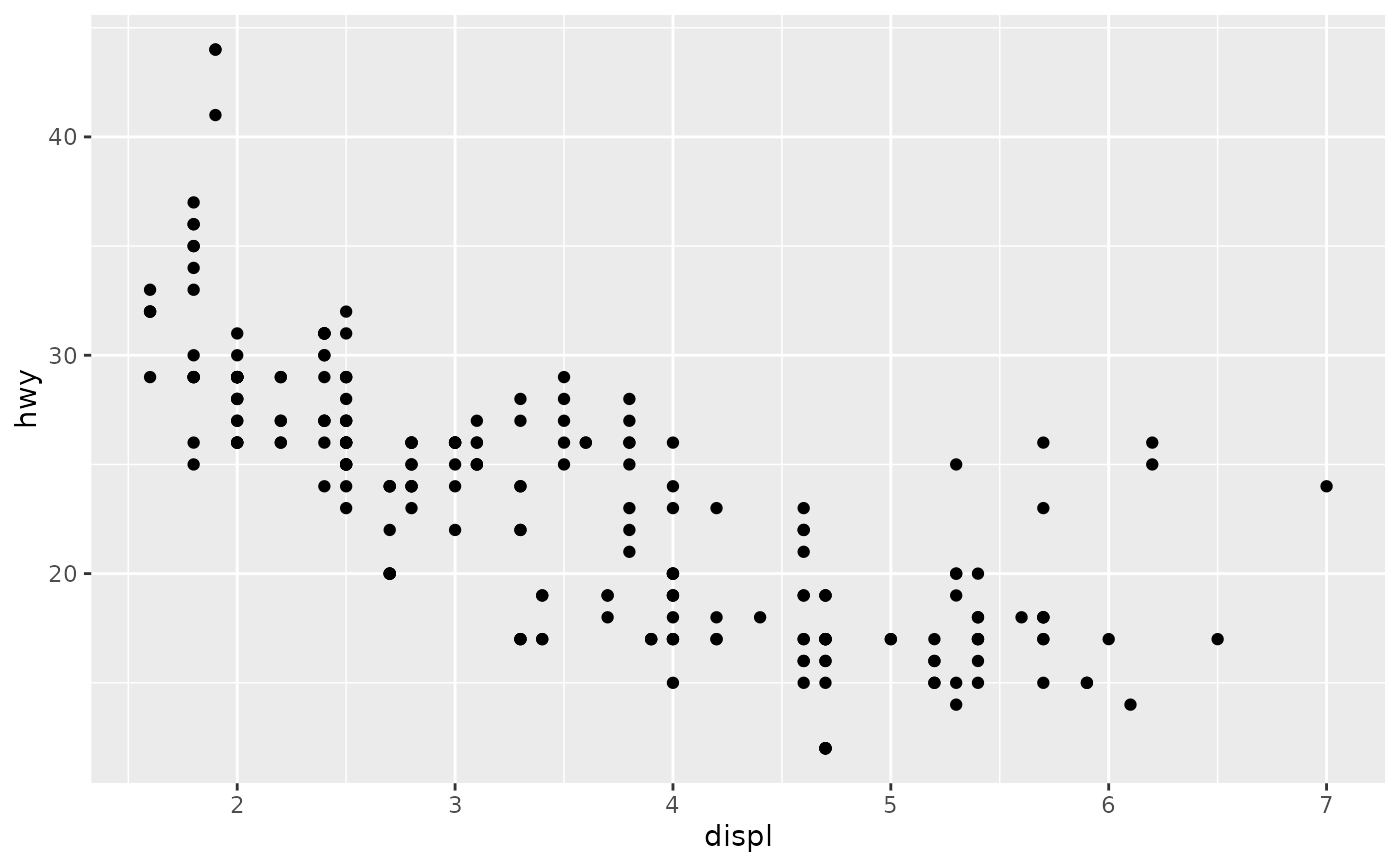A layer is a combination of data, stat and geom with a potential position
adjustment. Usually layers are created using geom_* or stat_*
calls but it can also be created directly using this function.
Usage
layer(
geom = NULL,
stat = NULL,
data = NULL,
mapping = NULL,
position = NULL,
params = list(),
inherit.aes = TRUE,
check.aes = TRUE,
check.param = TRUE,
show.legend = NA,
key_glyph = NULL,
layout = NULL,
layer_class = Layer
)Arguments
- geom
The geometric object to use to display the data for this layer. When using a
stat_*()function to construct a layer, thegeomargument can be used to override the default coupling between stats and geoms. Thegeomargument accepts the following:A
Geomggproto subclass, for exampleGeomPoint.A string naming the geom. To give the geom as a string, strip the function name of the
geom_prefix. For example, to usegeom_point(), give the geom as"point".For more information and other ways to specify the geom, see the layer geom documentation.
- stat
The statistical transformation to use on the data for this layer. When using a
geom_*()function to construct a layer, thestatargument can be used to override the default coupling between geoms and stats. Thestatargument accepts the following:A
Statggproto subclass, for exampleStatCount.A string naming the stat. To give the stat as a string, strip the function name of the
stat_prefix. For example, to usestat_count(), give the stat as"count".For more information and other ways to specify the stat, see the layer stat documentation.
- data
The data to be displayed in this layer. There are three options:
NULL(default): the data is inherited from the plot data as specified in the call toggplot().A
data.frame, or other object, will override the plot data. All objects will be fortified to produce a data frame. Seefortify()for which variables will be created.A
functionwill be called with a single argument, the plot data. The return value must be adata.frame, and will be used as the layer data. Afunctioncan be created from aformula(e.g.~ head(.x, 10)).
- mapping
Set of aesthetic mappings created by
aes(). If specified andinherit.aes = TRUE(the default), it is combined with the default mapping at the top level of the plot. You must supplymappingif there is no plot mapping.- position
A position adjustment to use on the data for this layer. This can be used in various ways, including to prevent overplotting and improving the display. The
positionargument accepts the following:The result of calling a position function, such as
position_jitter(). This method allows for passing extra arguments to the position.A string naming the position adjustment. To give the position as a string, strip the function name of the
position_prefix. For example, to useposition_jitter(), give the position as"jitter".For more information and other ways to specify the position, see the layer position documentation.
- params
Additional parameters to the
geomandstat.- inherit.aes
If
FALSE, overrides the default aesthetics, rather than combining with them. This is most useful for helper functions that define both data and aesthetics and shouldn't inherit behaviour from the default plot specification, e.g.annotation_borders().- check.aes, check.param
If
TRUE, the default, will check that supplied parameters and aesthetics are understood by thegeomorstat. UseFALSEto suppress the checks.- show.legend
Logical. Should this layer be included in the legends?
NA, the default, includes if any aesthetics are mapped.FALSEnever includes, andTRUEalways includes. It can also be a named logical vector to finely select the aesthetics to display. To include legend keys for all levels, even when no data exists, useTRUE. IfNA, all levels are shown in legend, but unobserved levels are omitted.- key_glyph
A legend key drawing function or a string providing the function name minus the
draw_key_prefix. See draw_key for details.- layout
Argument to control layout at the layer level. Consult the faceting documentation to view appropriate values.
- layer_class
The type of layer object to be constructed. This is intended for ggplot2 internal use only.
See also
The plot building chapter and geoms chapter of the online ggplot2 book.
Other layer documentation:
layer_geoms,
layer_positions,
layer_stats
Examples
# geom calls are just a short cut for layer
ggplot(mpg, aes(displ, hwy)) + geom_point()
 # shortcut for
ggplot(mpg, aes(displ, hwy)) +
layer(
geom = "point", stat = "identity", position = "identity",
params = list(na.rm = FALSE)
)
# shortcut for
ggplot(mpg, aes(displ, hwy)) +
layer(
geom = "point", stat = "identity", position = "identity",
params = list(na.rm = FALSE)
)
 # use a function as data to plot a subset of global data
ggplot(mpg, aes(displ, hwy)) +
layer(
geom = "point", stat = "identity", position = "identity",
data = head, params = list(na.rm = FALSE)
)
# use a function as data to plot a subset of global data
ggplot(mpg, aes(displ, hwy)) +
layer(
geom = "point", stat = "identity", position = "identity",
data = head, params = list(na.rm = FALSE)
)

